- Tech Industry Statistics
- MFA Statistics
- Streaming Services Statistics
- Mobile Vs. Desktop Usage Statistics
- AI Statistics
- Live Streaming Statistics
- Zoom Meeting Statistics
- Cord Cutting Statistics
- Digital Transformation Statistics
- Virtual Reality Statistics
- How Fast Is Technology Advancing
- Mobile Commerce Statistics
- SaaS Statistics
- Machine Learning Statistics
- Diversity In High Tech
- Cyber Security Statistics
- Ecommerce Statistics
- Tech Industry
- Gaming Industry
- Renewable Energy Job Creation
- Smartphone Industry
- Cybercrime Statistics
- Amazon Statistics
- Personalization Statistics
Research Summary. Digital transformation refers to the growing trend of companies adopting digital technologies to improve overall business processes and customer experience. It’s the step that’s taking the business world into the digital age officially, which comes with consequences of drastically altering the market across various industries.
To find out more, we’ve gathered the most essential digital transformation statistics. According to our research:
-
70% of organizations either have a digital transformation strategy or are currently working on one.
-
$1.5 trillion was spent on digital transformation globally in 2021.
-
Global spending on digital transformation is expected to reach $6.8 trillion by 2023.
-
56% of companies are prioritizing digital transformation worldwide as of 2021.
-
87% of business leaders think that digital transformation will disrupt their industry.
-
The top benefits of adopting a digital model are it improves operational efficiency (40%), allows for faster time to market (36%), and helps meet customer expectations (35%).
-
56% of CEOs said that their digital improvements have already improved profits
-
The digital transformation market spending is expected to grow at a CAGR of 19.1% over the next five years.
For further analysis, we broke down the data in the following ways:
Adoption | Benefits | Challenges | Industry | Future of Work
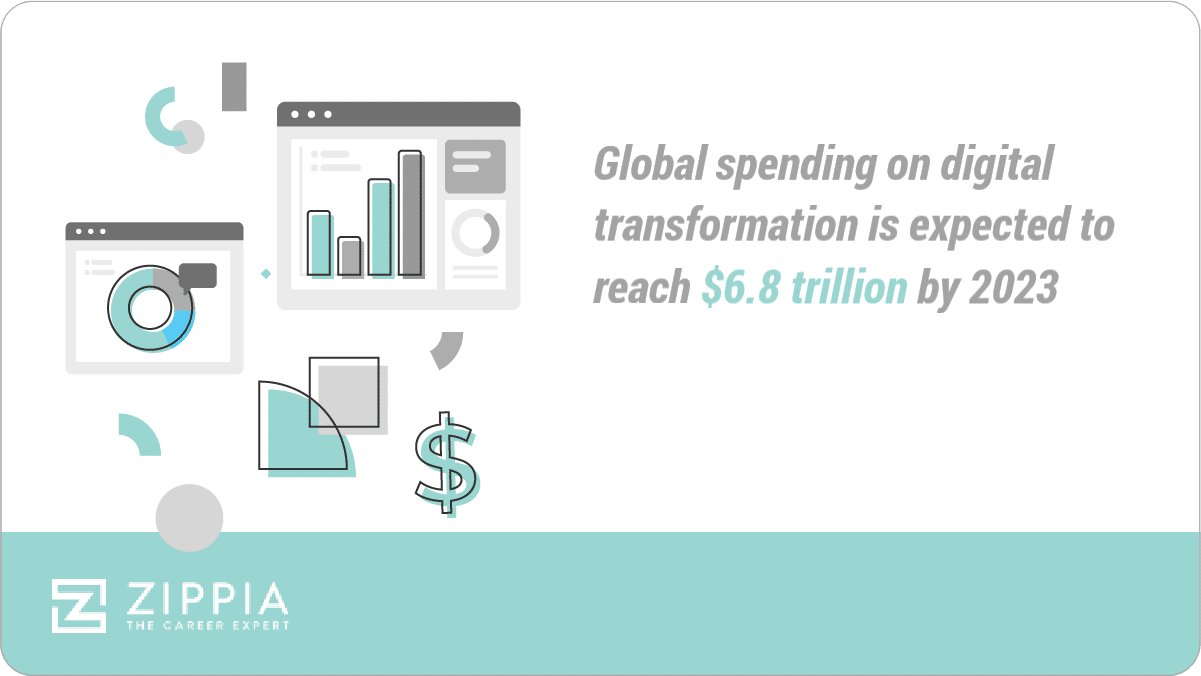
Digital Transformation Trends and Projections
-
Global spending on digital transformation is expected to reach $6.8 trillion by 2023
-
Digital transformation spending is expected to have a CAGR of 19.1% from 2021 to 2026
-
More than 90% of employers are planning to adopt a hybrid working model for their workers in 2022
-
97% of executives say that the COVID-19 pandemic sped up digital transformation efforts
Digital Transformation Statistics on Adoption
-
56% of companies are currently prioritizing digital transformation worldwide as of 2021.
This represents a growth of 2% from the previous year when 54% of companies were making digital transformation one of their main priorities instead of cybersecurity, cloud migration, and customer experience.
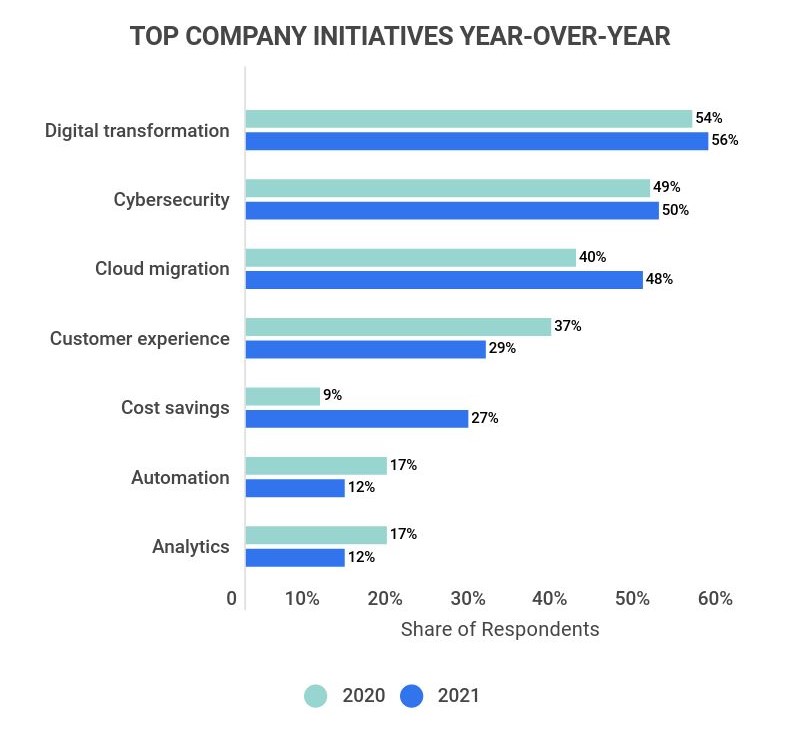
-
According to one survey of 1,010 CIOs, digital transformation leadership is one of the main priorities for CIOs at 58% of companies.
This means that at 3 out of 4 companies, the CIO contributes significantly to the imagination and strategy of digital transformation. Adding a new element and greatly expanding the responsibilities of CIOs.
-
Only 7% of companies have fully implemented digital transformation and are now in the maintenance phase.
The majority of companies, 28%, are still in the development stage of digital transformation.
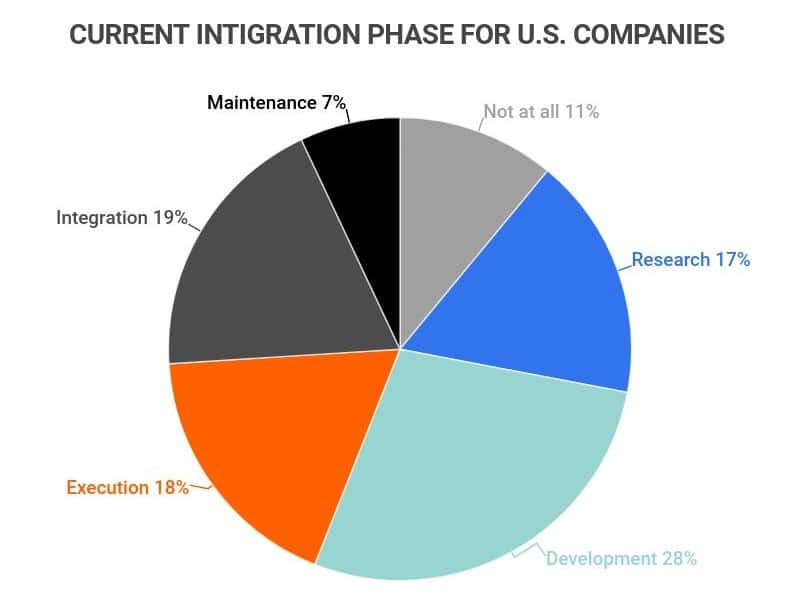
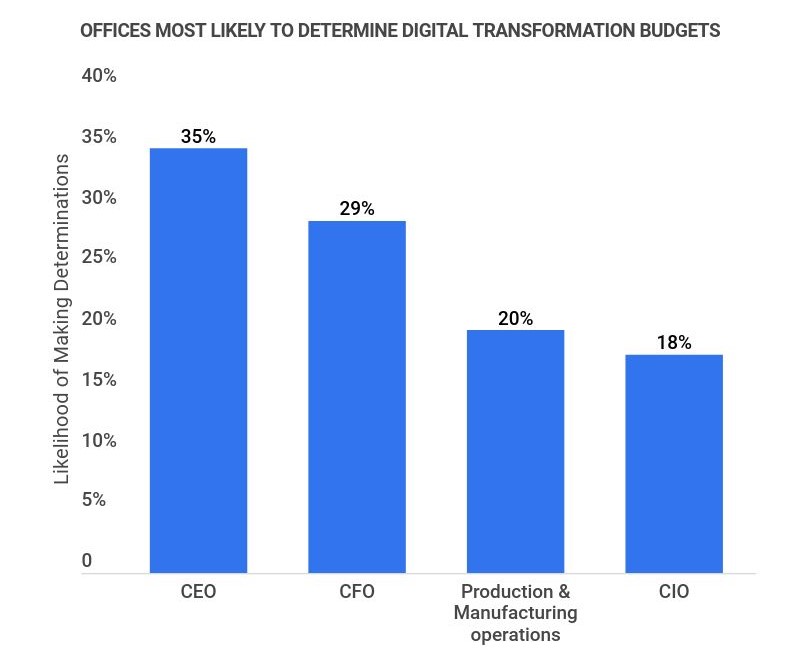
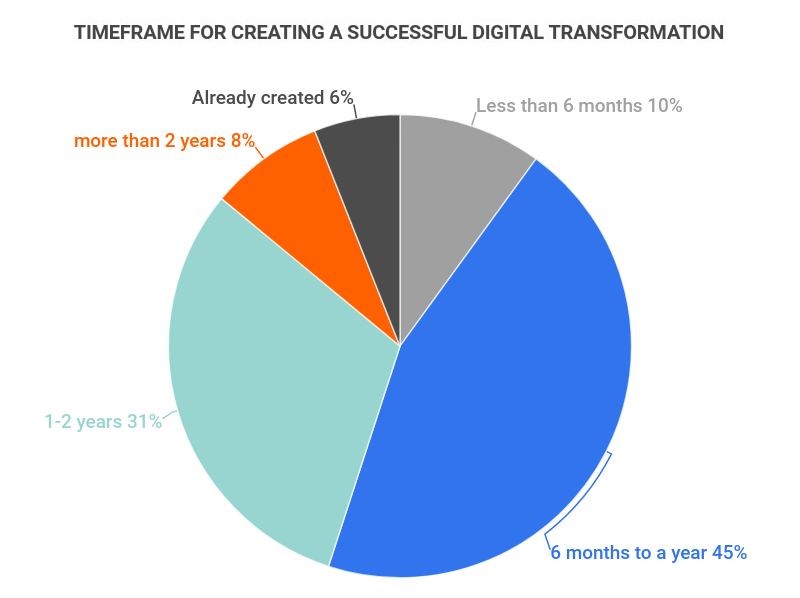
Benefits of Digital Transformation Statistics
-
Companies with digital-first strategies are 64% more likely to achieve their business goals than competitors
-
56% of CEOs said that their digital improvements have already improved their profits
-
Digitally mature companies are 23% more profitable than their less mature peers
Challenges of Digital Transformation Statistics
-
55% of companies without a digital transformation believe that they have less than a year before they begin losing market share.
Of the companies that haven’t started the digital transformation process, 59% are afraid that it might be too late for them.
-
87% of business leaders think that digital transformation will disrupt their industry.
While this large percentage of executives believe that digital transformation will disrupt their industry, only a mere 44% of them feel like their organization is prepared for this disruption.
Digital Transformation Statistics by Industry
-
The industries that are the most likely to adapt to digital transformation successfully are services (95%), financial services (93%), and healthcare (92%)
-
70.7% of retailers agree that digital transformation is an essential part of retail technology
-
According to one study, 95% of startups have digital business plans compared to 87% of traditional, well-established companies
-
52% of marketers use digital transformation as their top strategy to drive growth
-
One study found that only about 25% of financial institutions have begun digital transformation and that 45% of these institutions hadn’t launched a strategy until 2021
-
27% of senior executives believe that digital transformation is a matter of survival
Digital Transformation and the Future of Work
-
According to one survey, 85% of U.S. executives think that collaboration between humans and AI is the key to the future of business.
This statistic is a little lower around the world, at 79%. Additionally, 34% of marketing leaders believe that AI will lead to the biggest improvements in the customer experience.
-
35% of new jobs require proficient digital skills.
Alternatively, only 13% of jobs don’t require any digital skills, and 33% demand advanced digital skills.
-
86% of companies believe that cloud technology is critical to digital transformation.
In other words, three out of four organizations are betting that cloud technology is critical.
-
91% of enterprises currently have a digital-first business strategy or plan to adopt one.
Out of all industries, the healthcare field is rapidly adopting a digital-first business strategy, with 96% of healthcare IT decision-makers stating that their organizations have digital-first business plans.
Digital Transformation FAQ
-
What is the success rate of digital transformation?
The success rate of digital transformation is below 30%. Although digital transformation is the most popular up-and-coming business strategy that promises to boost efficiency and customer experience, it’s had a success rate of less than 30%.
While this percentage sounds low, and it is, this is partially attributed to its overall newness. Additionally, other researchers have come to different conclusions. One survey of companies that went down the digital transformation path found that 56% of CEOs said their digital improvements improved their profits.
It was also discovered that companies with digital-first strategies are 64% more likely to achieve their business goals than their competitors.
In other words, determining the successfulness of digital transformation is a bit of a toss-up right now.
-
Why is digital transformation important?
Digital transformation is important because it’s ushering in a new business era that functions virtually and is seeping into every single industry around the globe.
Many people believe that there are some attractive benefits to digital transformation like:
-
Improving data collection
-
Better resource management
-
More valuable insights about customers
-
A higher-quality customer experience
-
Improvements in productivity
-
Increased profits
Another reason digital transformation is important for every type of business to pay attention to is that it’s likely to change the entire market. Organizations that don’t build a digital strategy risk getting left behind.
This is a real concern for many companies, with 87% of business leaders thinking that digital transformation will disrupt their industry. Additionally, 55% of companies without digital transformation believe that they have less than a year before they start losing their market share.
-
-
What are the main areas of digital transformation?
The main areas of digital transformation are:
-
Process transformation
-
Business model transformation
-
Domain transformation
-
Cultural transformation
Process transformation requires changing the way businesses function to achieve their goals. This entails modernizing an organization’s processes, implementing new technology, and incorporating core systems.
Business model transformation refers to the alterations in a company’s overall structure when they start taking advantage of digital technologies. A great example of this is how Apple’s music delivery has changed over the years with the birth of new technologies.
Domain transformation is when a business successfully enters a new marketplace, like when Amazon started its streaming platform similar to Netflix or Hulu.
Finally, cultural transformation is the change beyond using new technologies and making new products to feed growing demand. It’s where the organization aligns its values with the digital process and helps foster a culture of understanding to advance digital transformation.
It’s perhaps the most critical transformation because it’s more likely for a company’s digital transformation to fail altogether without it.
-
-
Why does digital transformation fail?
The most common reasons digital transformation fails are not having the right data stored in the right place, poor onboarding processes, and employees’ resistance to change. However, it’s also common for digital transformation projects to fail because companies fail to set goals.
Often, these projects can be approached from the perspective of companies who are trying to look more visionary, futuristic, and positive, rather than actually embody these goals. In these cases, the project fails because it’s only serving as a source of vanity for the company.
Conclusion
Cartoons like the Jetsons have been predicting the impacts of technological advancement since the ‘60s. However, shows like this had fewer insights about how the digital age would change business. The reality we’re facing today is that the growing implementation of new technology in every professional industry is changing the market as a whole.
This is the concept behind digital transformation.
Digital transformation is the shift towards integrating technology into all domains of business. This is to change the way an organization functions for the better and improve the customer experience.
Today, the ball of digital transformation is rolling faster than ever. 70% of companies either have a digital transformation strategy or are currently working on one. Not to mention that global spending on digital transformation has already reached $1.5 trillion in 2021 and is expected to continue growing with a CAGR of 19.1% for the next five years.
This all sounds great, but it has the potential to stomp out the organizations that are late to the digital transformation party. While 87% of business leaders agree that digital transformation will surely disrupt their industry, only 44% of them feel prepared for this. Of the companies who are quick to adopt a digital-first strategy, there are 8% more startups than traditional companies.
With financial institutions being notably slow to begin their digital transformation process. 27% of senior executives believe digital transformation is a matter of survival, and 59% of companies are afraid it might be too late for them to adjust.
While it’s hard to tell whether digital transformation will positively or negatively impact business as a whole, one thing is for sure – it’s going to change everything.
References
-
ZDNet. “Survey: Despite steady growth in digital transformation initiatives, companies face budget and buy-in challenges | ZDNet.” Accessed on February 10, 2022
-
Statistica. “Spending on digital transformation technologies and services worldwide from 2017 to 2025“. Accessed on February 10, 2022
-
Flexera. “Top CIO Trends & Priorities in 2021 | Flexera Blog”. Accessed on February 10, 2022
-
MIT. “Moving Digital Transformation Forward.” Accessed on February 10, 2022
-
Gartner. “Gartner Survey Shows 42 Percent of CEOs Have Begun Digital Business Transformation“. Accessed on February 10, 2022
-
Yahoo Finance. The digital transformation market size to grow from USD 521.5 billion in 2021 to USD 1247.5 billion by 2026, at a Compound Annual Growth Rate (CAGR) of 19.1%. Accessed on February 10, 2022
-
Fierce Telecom. “Report: Digital transformation spending will catapult to $6.8 trillion by 2023“. Accessed on February 10, 2022
-
Harvard Business Review. “11 Trends that Will Shape Work in 2022 and Beyond“. Accessed on February 10, 2022
-
Forbes. 97% Of Executives Say Covid-19 Sped Up Digital Transformation. Accessed on February 10, 2022
-
CIO Dive. “CIOs lead digital transformation, but CEOs control the money.” Accessed on February 10, 2022
-
Digital Marketing Institute. “The What, Why & How of Digital Transformation.” Accessed on February 10, 2022
-
Clickz. “Digital transformation: What it is and why it matters in 2019“. Accessed on February 10, 2022
-
PTC. “Digital Transformation Report by CorporateLeaders and PTC.” Accessed on February 10, 2022
-
Forbes. “100 Stats On Digital Transformation And Customer Experience“. Accessed on February 10, 2022
-
Progress. “ARE BUSINESSES REALLY DIGITALLY TRANSFORMING OR LIVING IN DIGITAL DENIAL? A Report on the State of Digital Business“. Accessed on February 10, 2022
-
IDG. 2021 Digital Business Executive Summary. Accessed on February 10, 2022
-
Fujitsu. “Digital Transformation Trends.” Accessed on February 10, 2022
-
Technology Magazine. “Startups lead established companies in digital strategy adoption.” Accessed on February 10, 2022
-
Forbes. Digital Transformation In Banking: Banks Have A Long, Long Way To Go. Accessed on February 10, 2022
-
Accenture. “AI AND ME Unlock AI’s full potential through human-machine collaboration.” Accessed on February 10, 2022
-
ITIF. Assessing the State of Digital Skills in the US Economy | ITIF. Accessed on February 10, 2022
-
IDG. “There’s No Looking Back – The Future of Business is Digital.“Accessed on February 10, 2022
-
McKinsey. The keys to a successful digital transformation | McKinsey. Accessed on February 10, 2022
-
Virtue. “What are the Benefits of Digital Transformation?“. Accessed on February 10, 2022
-
Poppulo. “The 4 Main Areas of Digital Transformation“. Accessed on February 10, 2022
-
Forbes. “13 Industry Experts Share Reasons Companies Fail At Digital Transformation“. Accessed on February 10, 2022
- Tech Industry Statistics
- MFA Statistics
- Streaming Services Statistics
- Mobile Vs. Desktop Usage Statistics
- AI Statistics
- Live Streaming Statistics
- Zoom Meeting Statistics
- Cord Cutting Statistics
- Digital Transformation Statistics
- Virtual Reality Statistics
- How Fast Is Technology Advancing
- Mobile Commerce Statistics
- SaaS Statistics
- Machine Learning Statistics
- Diversity In High Tech
- Cyber Security Statistics
- Ecommerce Statistics
- Tech Industry
- Gaming Industry
- Renewable Energy Job Creation
- Smartphone Industry
- Cybercrime Statistics
- Amazon Statistics
- Personalization Statistics






